2 虚拟地理环境教育部重点实验室(南京师范大学), 江苏 南京 210023;
3 江苏省地理信息资源开发与利用协同创新中心, 江苏 南京 210023)
亚洲季风区是世界上人口最稠密的地区,季风降水的变化对亚洲地区的经济和社会持续发展至关重要。亚洲季风环流是全球气候系统的重要组成部分,在动力学机制上既通过欧亚大陆雪盖响应于北大西洋气候突变[1],也通过越赤道气流与南大洋紧密联系[2]。末次冰期千年尺度气候变化频繁发生,南北高纬呈现不同的变化特征,以格陵兰为代表的北高纬温度变化以大幅快速突变为主[3~5],而南极冰芯记录则显示出低幅缓慢的特点[6~7]。千年尺度季风事件如何响应南北高纬两种截然不同的气候变化一直是古气候学研究关注的焦点[8~9]。
Porter和An等[10]通过研究中国黄土高原粉尘堆积层序中的粒度指标,首次揭示了北大西洋地区冰漂碎屑事件与亚洲冬季风强弱变化的耦合关系,并解释为北大西洋气候变化通过西风带传输到亚洲大陆;Guo等[11]在黄土序列中发现最近两个冰期旋回期间亚洲冬季风增强事件一一对应于北大西洋地区冰漂碎屑事件,将季风与北高纬的联系推广到了更老时段;兰州高分辨率黄土记录显示出末次冰期亚洲夏季风千年尺度的气候振荡与格陵兰冰芯记录的气候事件对应良好,反映夏季风也可能受到北大西洋地区气候扰动的影响[12];中国西南泥炭岩芯记录了末次冰期和全新世印度季风降水和季风强度千年尺度事件,与北大西洋地区的气温变化紧密相关[13];Wang等[14]通过葫芦洞石笋U-Th定年和方解石δ18O序列,发现千年尺度亚洲夏季风强弱变化一一对应于格陵兰地区千年尺度事件,奠定了北半球高低纬之间同步变化的基础。以上这些研究结果表明亚洲季风千年尺度振荡主要受到北高纬地区气候变化的控制。
然而,Barker和Knorr[15]对葫芦洞记录的进一步研究发现,亚洲季风千年尺度突变事件明显包含了南极风格的气候变化信号,且亚洲季风源区西太平洋暖池的气候记录与南极记录更相似。这一发现证明亚洲季风并非单一受控于北高纬气候变化,与南极地区气候波动也存在紧密关联。云南小白龙洞的石笋记录刻画了DO12事件的细节变化特征,其开始时呈缓慢变化特征,这一过程与格陵兰快速升温明显不同,而是十分类似南极温度变化[16];雾露洞石笋记录的末次冰期亚洲季风中国间冰阶4.1事件(Chinese Interstadial 4.1,简称CIS4. 1事件)和CIS8事件的演变模式与北高纬气温记录存在差异,与南极冰芯EDML记录更为相似[17];另外,山西Dragon洞石笋的δ18O记录反映48~38kaB.P.期间东亚夏季风总体增强不同于格陵兰气温总体下降,而与南极气温总体变化趋势一致[18]。这说明亚洲季风事件同样受到南高纬气温变化的深刻影响。
亚洲季风千年尺度事件到底是受南高纬气候变化的影响,还是被北高纬控制?这一问题的深入探讨不仅能够促进对亚洲季风成因机制的理解,也有助于对亚洲季风未来变化趋势的预测。Rohling等[19]利用直接的统计学方法研究季风记录中所包含的南北两极信号比例,发现不同的气候背景下,南北高纬对亚洲季风事件的影响程度不同;Chen等[20]将去除北半球太阳辐射信号的永兴洞石笋δ18O序列与去除冰量的南极冰芯EDC记录进行比对,发现亚洲弱季风事件与南极暖事件呈seesaw模式响应。种种迹象表明轨道尺度的气候背景不仅控制了千年事件的发生频率,也影响了其变化特征[21~22]。这些都强烈暗示:应该在不同的气候背景下研究亚洲季风事件与南北高纬气候变化的响应关系。
基于上述思想,本文利用落水洞的一支石笋(编号:LS23)15个230Th年龄和830个δ18O数据,重建了深海同位素2阶段(Marine Isotope Stage 2,简称MIS2)和同位素5a阶段(MIS5a)亚洲季风的演化历史。相比同时段的葫芦洞石笋MSD(平均分辨率约80a)和永兴洞石笋YX51和YX46(平均分辨率分别约45a、110a),本文的研究样品落水洞石笋LS23在28.7~22.2kaB.P.和87.0~82.9kaB.P.两个时段内平均分辨率分别约为20a和15a,15个U-Th年龄较为精确限定了H2事件(Heinrich 2 Event)和DO21事件(Dansgaard-Oeschger 21 Event)的发生时段,更能从细节上刻画这两个时段内季风演变的结构特征。通过分析石笋LS23记录的H2事件、DO21事件与南极冰芯EDML[23]、格陵兰冰芯GISP2记录[24]中对应气候事件演变模式的联系,讨论南、北高纬气候变化在不同气候背景下对亚洲季风的驱动作用。
1 样品和方法落水洞位于湖北省恩施咸丰县西北的龙家盖(29°44′N,109°07′E) (图 1),地处云贵高原东部延伸区,发育于咸丰大断裂和砂子坡断裂之间的次级断裂带上。落水洞所在区域喀斯特地貌广布,沟壑纵横,海拔落差大,地质历史时期发生过多次造山运动,造就了咸丰地区总体地形呈南北高、中间低的特征。该洞穴位于典型的亚热带季风气候区,四季分明,植被覆盖率较高;年平均气温约14℃,年均降雨量约1400mm,其中67 %的降水集中在5~9月(图 2),该地区降水集中的时段为夏季风盛行期。落水洞洞口宽21.2m,高37.2m,海拔为975m,位于峰丛洼地下部,洞道岩壁有明显水溶蚀波痕。洞穴内年均温约14.5℃,洞内存有大量的石笋、石钟乳等次生化学沉积物(图 3)[25~26]。
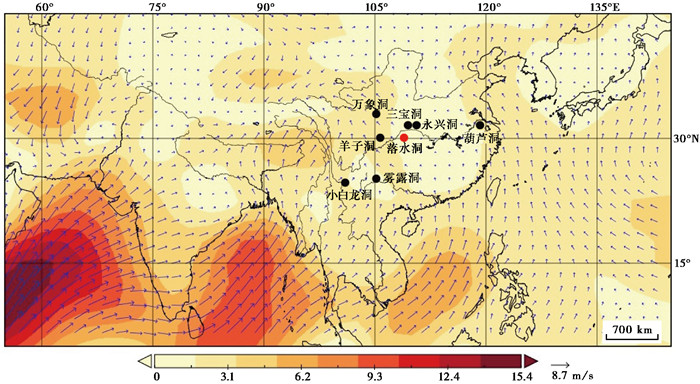
|
图 1 研究区域1970~2018年夏季(6~8月)大气风场图以及本文研究点和其它洞穴位置 蓝色箭头指示风向和风速;m/s表示风速单位;红色圆点表示落水洞(29°44′N,109°07′E),黑色圆点分别表示葫芦洞(32°30′N,119°10′E)、永兴洞(31°35′N,111°14′E)、三宝洞(31°40′N,110°26′E)、万象洞(33°19′N,105°00′E)、雾露洞(26°03′N,105°05′E)、小白龙洞(24°12′N,103°21′E)、羊子洞(29°47′N,107°47′E) (数据来源:https://www.esrl.noaa.gov/psd/cgi-bin/data/getpage.pl) Fig. 1 Summer atmospheric wind field map of the research area from 1970 to 2018 and the location of this study and part of the geological records. The blue arrow indicates the direction of the wind; m/s is a unit of wind speed; The red dot represents location of Luoshui Cave(29°44′N, 109°07′E); The black dots represent location of other caves including Hulu Cave(32°30′N, 119°10′E), Yongxing Cave(31°35′N, 111°14′E), Sanbao Cave(31°40′N, 110°26′E), Wanxiang Cave(33°19′N, 105°00′E), Wulu Cave(26°03′N, 105°05′E), Xiaobailong Cave(24°12′N, 103°21′E), Yangzi Cave(29°47′N, 107°47′E). Data source:https://www.esrl.noaa.gov/psd/cgi-bindatagetpage.pl |
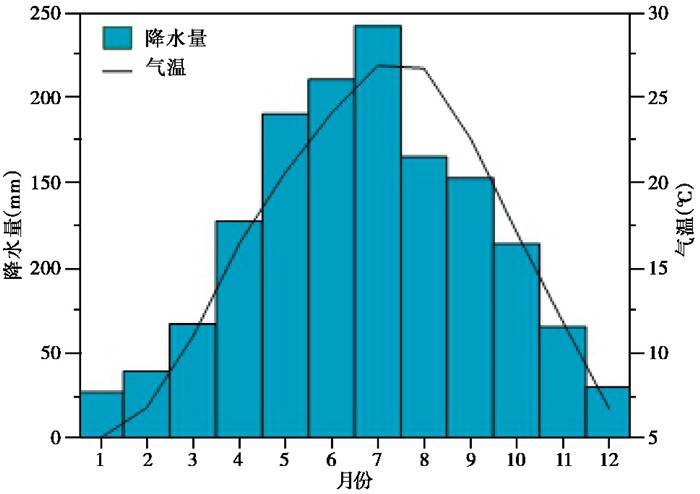
|
图 2 恩施1951~2010年月平均降水-气温图 数据来源:中国气象数据网 Fig. 2 Average monthly precipitation and temperature of Enshi from 1951 to 2010. Data source:National Meteorological Information Center |
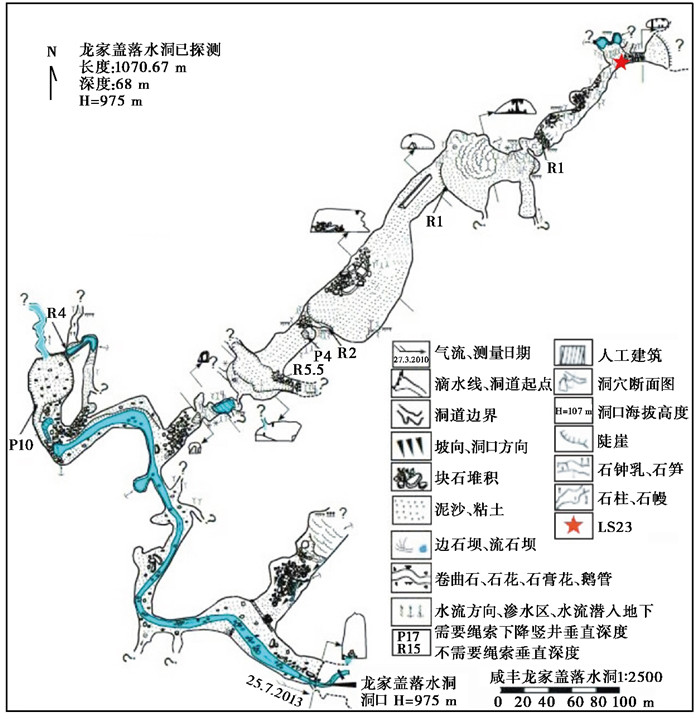
|
图 3 落水洞洞穴平面图[26] Fig. 3 The cave map of Luoshui Cave |
LS23石笋样品,外观为黑色圆锥体,长830mm,底部直径约70mm。沿石笋LS23生长轴切开后抛光,剖面呈较纯净的方解石(图 4)。LS23在308~310mm和610~614mm段岩性特征存在显著变化,这两处方解石分别呈深灰色和灰黑色,且有杂质,而其他段为纯净的灰白色方解石(图 4),指示石笋在这两个地方存在显著的沉积间断。用直径0.9mm的牙钻在石笋抛光面上共采集15个样品用于U/Th定年,测试仪器为多接收电感耦合等离子体质谱仪Neptune_Plus(MC-ICP-MS),由南京师范大学石笋同位素实验室和南洋理工大学新加坡地球观测台同位素地球化学实验室测试完成,化学实验方法分别参照李春华等[27]、Shao等[28]和Cheng等[29],年龄分析误差为±2σ,测试结果见表 1。用直径1mm的牙钻沿石笋生长中心轴每1mm取一个样品,共计830个样品,采用碳酸盐自动进样装置以及Finnigan MAT-253型质谱仪联机完成测试,每9个样品插1个标准样品(NBS-19),δ18O分析误差优于0.06 ‰,VPDB标准,由南京师范大学石笋同位素实验室测试完成。

|
图 4 落水洞石笋LS23抛光面 红点表示测年点位置;黑色箭头表示沉积间断 Fig. 4 Polished surface of the sample LS23 from Luoshui Cave. The red dots indicate the position of sub-samples for dating. The black arrows stand for the position of hiatus |
| 表 1 落水洞石笋LS23铀系测年结果* Table 1 U-series dating results of stalagmite LS23 from Luoshui Cave |
LS23的15个U/Th测年结果如表 1所示,该石笋品质较好,样品238U含量在530.1~1189ug/L之间,232 Th含量在146~1776ng/L之间,年龄误差范围在50~390a之间。从测年结果上看,石笋LS23在308~310mm和610~614mm段与其他部分较均匀的生长速率差异较大,这两处的生长速率分别是0.18mm/ka、3.26mm/ka,而其他部分的平均生长速率约为72.6mm/ka;支持了上文的岩性分析结果,即石笋在308~310mm和610~614mm段存在沉积间断。本文采用相邻测年点间线性内插、测年点外至石笋顶部和沉积间断两侧线性外推的方法建立LS23的年龄模式,获得了石笋LS23每个氧同位素的年龄(图 5和6)。LS23石笋的生长期跨越28.7~22.2kaB.P.(0~306mm)、87.0~82.9kaB.P.(316~610mm)和93.7~91.6kaB.P.(625~830mm)3个时段。由于石笋LS23在625~830mm之间没有记录突出的千年尺度季风事件,本文的研究主要聚焦在LS23石笋的0~306mm和316~610mm两个部分。
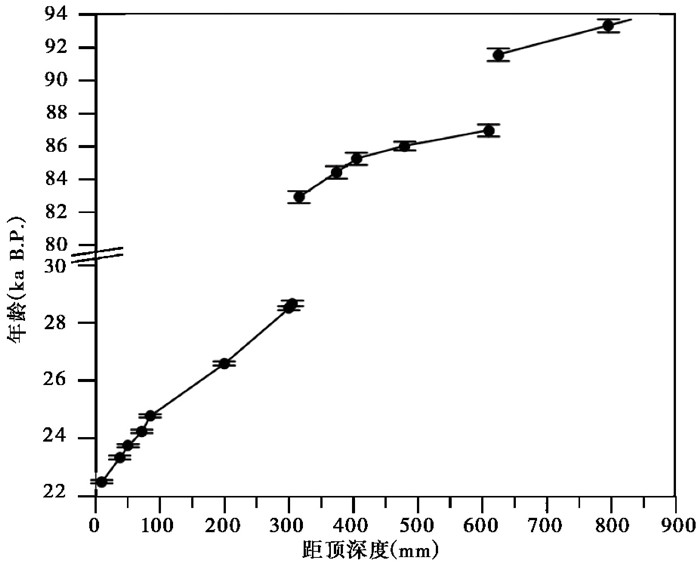
|
图 5 落水洞石笋LS23生长速率图 黑色圆点表示校正后的230Th测年结果;误差棒表示石笋记录的测年误差(±2σ) Fig. 5 Growth rate of stalagmite LS23 from Luoshui Cave. Black dots represent corrected 230Th dating results; Error bars indicate the range of age errors(±2σ) |
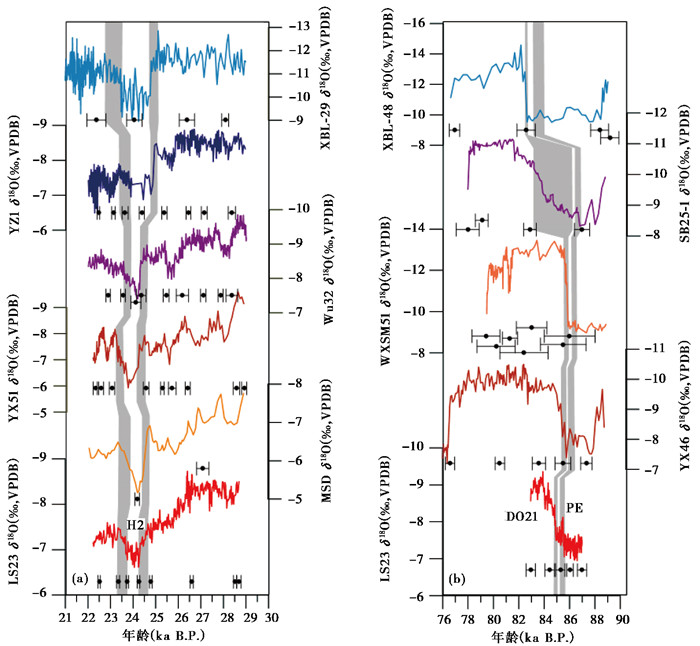
|
图 6 落水洞LS23石笋δ18O序列与其他洞穴石笋记录的对比 (a)H2事件记录对比,(b)DO21事件记录对比;灰色条带表示H2、DO21事件的开始、结束过程以及PE事件;误差棒表示各石笋的测年误差 Fig. 6 Comparison of the δ18O of LS23 from the Luoshui Cave and other records. (a)Comparison of H2 event; (b)Comparison of DO21 event. Gray bars represent the onset and termination of each events; The error bar represents the dating error of each stalagmites |
据已有的研究成果,石笋δ18O值负向漂移指示亚洲夏季风增强;反之,夏季风减弱[14, 25, 30~34]。基于LS23线性内插时标,建立了28.7~22.2kaB.P.和87.0~82.9kaB.P.两个时段内平均分辨率分别约20a和15a的石笋δ18O变化序列(图 6)。石笋LS23的δ18O值在28.7~24.2kaB.P.期间以2.1 ‰的振幅整体偏正,表明此时亚洲季风呈减弱趋势;在24.2~22.2kaB.P.之间δ18O值以1 ‰的振幅偏负,此阶段亚洲季风增强。在87.0~82.9kaB.P.期间,LS23的δ18O值整体偏负,振幅约2.4 ‰,此时亚洲季风增强。将石笋LS23的δ18O序列与同区域的葫芦洞石笋MSD[14]、永兴洞石笋YX51和YX46[20]、三宝洞石笋SB25-1[22]、小白龙洞石笋XBL-29和XBL- 48[35]、羊子洞石笋YZ1[36]、雾露洞石笋Wu32[37]、万象洞石笋WXSM51[38]进行对比(图 6),发现在28.7~22.2kaB.P.和87.0~82.9kaB.P.两个时段内LS23石笋δ18O值的总体变化趋势分别与其他洞穴记录的重现性较好,表明石笋LS23的δ18O能够反映大尺度季风环流特征,指示亚洲季风强度变化。
如图 6所示,相对于亚洲季风区同时期的其他石笋记录,LS23石笋记录存在两大优势:1)定年精度较好、误差较小。LS23在H2事件期间有4个年龄控制点,且测年误差在约50~70a之间,比葫芦洞石笋MSD[14]、永兴洞石笋YX51[20]、雾露洞石笋Wu32[37]、羊子洞石笋YZ1[36]和小白龙洞石笋XBL-29[35]的测年点更多且误差更小。在DO21事件期间,LS23石笋有5个年龄控制点,测年误差在约260~380a之间,明显优于永兴洞石笋YX46[20]、三宝洞石笋SB25-1[22]、万象洞石笋WXSM51[38]和小白龙洞石笋XBL-48[35]的年代学数据。2)分辨率高。LS23石笋在H2事件和DO21事件期间样点分辨率分别约为30a和25a,尽管在H2事件期间,除葫芦洞石笋MSD[14]的分辨率相对较低以外,永兴洞石笋YX51[20]、雾露洞石笋Wu32[37]、羊子洞石笋YZ1[36]和小白龙洞石笋XBL-29[35]的时间分辨率与LS23记录相当,但LS23的年代学优势使得该石笋记录更能从细节上较精确反映季风在该事件期间演变的结构特征。尤其在DO21事件期间,三宝洞石笋SB25-1[22]、万象洞石笋WXSM51[38]和永兴洞石笋YX46[20]的平均分辨率均超过50a,且小白龙洞石笋XBL-48[35]的分辨率达200a,而LS23的分辨率明显优于该时期的其他石笋记录。因此,LS23记录可以捕捉到季风事件的内部结构和转型特征,便于和南北两极冰芯记录进行对比。
3 讨论 3.1 LS23石笋记录的亚洲季风H2事件、DO21事件结构特征高分辨率石笋LS23记录了亚洲季风在H2事件期间和DO21事件开始阶段的演化历史,同时两个事件的内部结构特征和转型过程在季风区石笋记录中具有广泛的相似性特征[14, 20, 22, 35~38],说明这种季风演化过程在亚洲季风区具有一致性,也表明受到的主要影响因素一致。为了进一步建立季风事件与南北高纬气候之间的联系,甄别不同气候背景下季风演化的影响因素,选取南极高分辨率EDML冰芯[23]和格陵兰GISP2冰芯[24]的δ18O记录,与石笋LS23记录进行对比(图 7和8)。
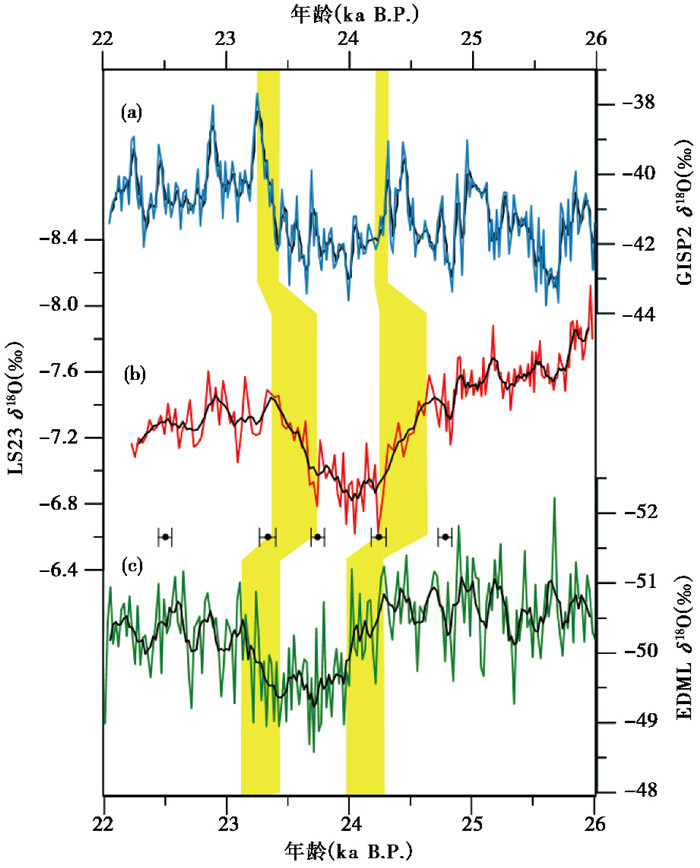
|
图 7 石笋LS23与南、北极冰芯记录H2事件模式对比 (a)格陵兰冰芯GISP2δ18O记录[24];(b)落水洞LS23石笋δ18O记录;(c)南极冰芯EDML δ18O记录[23]黄色条带表示H2事件的开始和结束过程;黑色实线表示5点滑动平均曲线;黑色误差棒为LS23测年误差。 Fig. 7 Detailed comparison of H2 event between LS23 (b)and GISP2 (a)and EDML (c). Yellow bars indicate the onset and termination of H2 event; The solid black line represents the moving average of 5-point; The black error bar is the age error of LS23 |
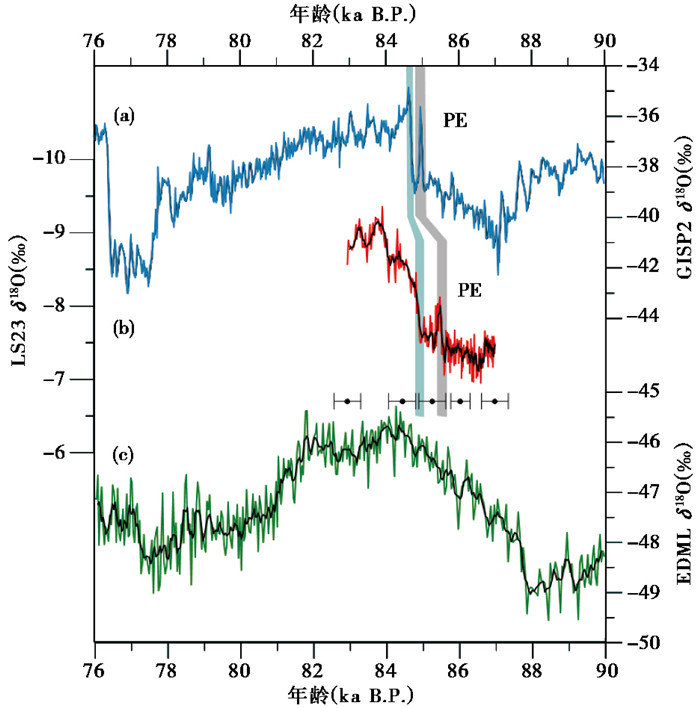
|
图 8 石笋LS23与南、北极冰芯记录DO21事件模式对比 (a)格陵兰冰芯GISP2 δ18O记录[24];(b)落水洞LS23石笋δ18O记录;(c)南极冰芯EDML δ18O记录[23]蓝色条带表示DO21事件的开始过程;灰色条带表示PE事件;黑色实线表示5点滑动平均曲线;黑色误差棒为LS23测年误差 Fig. 8 Detailed comparison of DO21 event between LS23 (b)and GISP2 (a) and EDML (c). The blue bar indicates the onset of DO21 event, the gray bar represents PE event and the solid black line represents the moving average of 5-point; The black error bar is the age error of LS23 |
在H2事件的开始阶段,石笋LS23的δ18O值在24.7~24.3kaB.P.之间逐渐偏正,振幅约1 ‰,此时亚洲季风逐渐减弱,持续时间约400a;在23.7~23.4kaB.P.期间石笋LS23的δ18O值缓慢偏负,振幅为0.7 ‰,表明亚洲季风逐渐增强,该过程持续时间约300a(图 7b)。总体上,LS23记录的H2事件呈现“V”型结构特征。这个“V”型特征得到了同区域其他洞穴,如葫芦洞[14]、永兴洞[20]、雾露洞[37]、羊子洞[36]石笋记录的支持(图 6a)。当然,仔细观察也会发现各石笋记录的H2事件开始和结束过程也存在细微差异。例如,在H2事件开始过程中,羊子洞石笋YZ1[36]、雾露洞石笋Wu32[37]的δ18O记录偏正的持续过程稍短于LS23记录,这可能与YZ1[36]在该时段时间分辨率较低(约60a)、Wu32[37]的测年误差(约200a)较大相关。在H2事件结束过程中,永兴洞石笋YX51[20]和雾露洞石笋Wu32[37]δ18O值偏负的持续时间稍短于LS23,原因在于这两支石笋对H2事件的年龄控制点较少且测年误差都大于LS23,所以导致永兴洞石笋YX51[20]和雾露洞石笋Wu32[37]记录的H2事件结束时长与LS23存在略微差异。另外,云南小白龙洞石笋XBL-29[35]显示H2事件的持续时间和结束过程都较长,且该记录在H2事件内部存在多次年代际尺度上的波动变化,这个特征也显著区别于其他石笋记录。小白龙洞石笋XBL-29[35]在H2事件期间仅存在2个年龄控制点,且测年误差在300~400a之间,较大的年龄误差和较少的年代控制可能是XBL-29[35]在H2事件期间显著不同于其他石笋记录的主要原因。因此,受时间分辨率和测年误差及年龄控制点的影响,各石笋记录在H2事件期间存在细微差异,但总体反映H2事件结构呈“V”型演化模式,表明亚洲季风H2事件的演化模式具有区域性特征。
LS23记录的H2事件“V”型特征与南极冰芯EDML记录的南极暖事件2(Antarctic Isotope Maximum 2,简称AIM2事件)非常相似[23]。在24.3~24.0kaB.P.期间,冰芯EDML的δ18O值缓慢偏正,振幅约2.3 ‰,持续时间长达约300a,此时南极地区气温上升,气候呈变暖趋势;南极AIM2事件的结束过程也比较缓慢,冰芯EDML的δ18O值在23.4~23.1kaB.P.期间缓慢偏负,振幅约2.1 ‰,持续时间约300a[23](图 7c)。尽管H2事件的发生时间在石笋LS23记录和格陵兰冰芯GISP2记录中基本一致[24],但演化模式存在差异。如H2事件开始时,冰芯GISP2的δ18O值迅速偏负,振幅超过了2.5 ‰,持续时间仅约40a,指示格陵兰地区气温迅速下降;在23.4~23.3kaB.P.期间,GISP2的δ18O值偏正,振荡幅度达4.5 ‰,表明北极地区气温上升,此过程持续时长明显短于季风记录[24](图 7a)。因此,在格陵兰冰芯记录中,H2事件的开始和结束过程变化快速,其演化模式呈“U”型结构特征[24],与LS23石笋记录及亚洲季风区其他石笋记录存在显著差异。
尽管末次冰期石笋记录较多,但是覆盖DO21事件的高分辨率、高定年精度的石笋记录还比较缺乏,LS23石笋完整记录了DO21事件开始阶段的结构特征,为进一步研究DO21事件的触发机制提供了数据基础。LS23石笋的δ18O值在84.9~84.8kaB.P.期间快速偏负,变化幅度约为1 ‰,该过程仅持续约100a,表明此阶段亚洲夏季风快速增强(图 8b)。更为重要的是,LS23记录中识别出了发生在DO21事件之前的PE事件(Precursor-type Peak Event),δ18O值在PE事件期间呈快速、大幅度变化特征。LS23石笋记录的DO21事件的起始过程也得到了亚洲季风区其他洞穴石笋记录的支持,如永兴洞石笋YX46[20]、万象洞石笋WXSM51[38]和小白龙洞石笋XBL-48[35]记录都表明在DO21事件的起始阶段,亚洲季风呈现快速增强的过程,与格陵兰冰芯记录具有显著的一致性[24];然而湖北神农架三宝洞石笋SB25-1[22]却没有反映出DO21事件开始时季风快速变化的特征(图 6b),这可能是由于该石笋的平均分辨率较低、测年误差较大,同时三宝洞洞穴可能存在较大的“库效应”,导致石笋δ18O缺乏高频振荡。同时段的三宝洞石笋SB25- 1[22]、永兴洞石笋YX46[20]、万象洞石笋WXSM51[38]和小白龙洞石笋XBL-48[35]也存在PE事件(图 6b),但是变化幅度相对于LS23石笋记录显著偏小,开始和结束过程相对不明显,这可能与这些洞穴石笋记录的时间分辨率较低相关。
格陵兰冰芯GISP2的δ18O值在84.8~84.6kaB.P.快速上升[24](图 8a),此时北极地区快速升温,DO21事件的开始过程在约200a内完成,这与LS23记录的亚洲季风的变化特征相似。格陵兰冰芯GISP2记录中发生在DO21事件之前的PE事件,其结构特征表现为非常快速的开始和结束,整个过程持续时长约300a[24](图 8a),演化特征与LS23记录非常相似。LS23与格陵兰冰芯记录在DO21事件开始阶段和PE事件期间相似的变化特征[24],表明亚洲季风与北高纬气候变化存在快速的响应过程。LS23石笋记录与南极冰芯EDML记录对比结果显示,在DO21事件的开始阶段,南极表现为非常缓慢的降温[23](图 8c),未发现类似于格陵兰冰芯记录的PE事件[24],这与亚洲季风、北高纬气候演化模式显著不同。另外,Cariaco海盆沉积物总反射率记录的PE事件也呈现出与LS23记录一致的结构特征[39]。格陵兰冰芯NGRIP[40]、欧洲石笋BA1、EXC4和EXC3[41]以及中国贵州三星洞石笋SX7[42]也记录了发生在DO事件之前的PE事件,其结构特征都表现为事件的开始和结束过程气候变化迅速。以上研究表明,至少在MIS5a期间,亚洲季风在千年-百年尺度上的演化快速响应北高纬温度变化。
同时,我们也注意到季风事件DO21开始时和格陵兰冰芯[24]基本一致,但随后,二者呈现出不同的变化模式:格陵兰冰芯开始降温[24],而季风事件则维持在一个稳定的水平。这种明显不同的变化模式可能体现了北高纬和季风各自的区域协调性特征。
3.2 亚洲季风千年尺度事件与南北高纬气候变化的联系亚洲季风区是连接南北半球气候变化的纽带,已有的研究也显示季风演化在千年尺度上受到两半球高纬度气候变化的同时控制[16, 19, 43],然而在何种背景下,季风气候主要受到北高纬或南高纬影响仍存在不确定性,需要结合季风区高精度定年、高时间分辨记录与高纬度记录进行进一步的对比研究。LS23石笋覆盖末次间冰期MIS5a和冰期MIS2两个时段,为解决这个问题提供了高精度定年、高时间分辨率的关键材料。该石笋记录的亚洲季风千年尺度强度变化对南、北高纬气候的响应在不同时期存在差异,在DO21事件的开始阶段以及PE事件期间,季风强度变化呈现出与北高纬气候变化一致性的特征[24],指示北高纬气候在千年尺度上对亚洲季风演化的主导作用;在H2事件期间,季风的事件模式与南高纬AIM2事件的演变基本一致[23],说明此时南高纬气候驱动季风演化。H2、DO21事件分别处于MIS2、MIS5a阶段,其气候背景分别是冰期和间冰期,表明亚洲季风在不同气候背景下可能存在不同的驱动机制。
LS23石笋记录与南极冰芯记录[23]的对比研究显示,亚洲季风在H2事件期间的开始和结束及整体形态都与南极有较好的相似性,表明在H2事件期间亚洲季风显著受到南极温度变化的影响。印度乞拉朋齐高精度定年的石笋δ18O记录也证明了印度季风在H2事件结束过程中,受到南极温度缓慢上升的影响,与南极气候变化表现出相似的演变过程[44]。多个研究显示低纬水汽循环与南极气候之间存在遥相关关系[45~46],主要是通过热带辐合带(Intertropical Convergence Zone,简称ITCZ)的经向移动和越赤道气流产生联系[16, 19, 47]。H2事件期间,南半球处于较温暖的气候状态,ITCZ的平均位置南移,亚洲季风活动减弱[48]。现代观测结果显示,印度洋南部马斯克林高压(Mascarene High)的变化与东亚地区长江流域的夏季降水呈正相关,马斯克林高压作为桥梁能够将南极地区的气候信号传递到东亚季风区[36, 49],其与印度低压之间的气压梯度变化会影响越赤道气流的强度,进而对印度夏季风及东亚季风产生影响[19, 47]。根据Han等[50]模拟研究的结果,中国石笋δ18O值在Heinrich事件期间较高主要是受印度夏季风强度减弱的影响,在H2事件期间,南极EDML冰芯δ18O值反映此阶段南极地区气温较高,受南极升温影响,此时的马斯克林高压减弱,越赤道气流(Cross equatorial flow)随着马斯克林高压与印度低压之间的气压梯度减弱而削减,导致亚洲夏季风减弱[36, 47, 49]。因此,此阶段亚洲季风千年尺度的波动带有明显的南高纬气候信号。Lynch- Stieglitz[51]的模拟结果显示,冰期大西洋经向翻转流(Atlantic Meridional Overturning Circulation,简称AMOC)呈较弱的运动模态。综上所述,H2期间,全球冰量明显增加(主要是北半球),海平面比现在低120m以上,北半球夏季太阳辐射减少[52~53],从而减弱了北高纬对季风的作用。这一时期北半球夏季风活动整体偏弱,ITCZ平均位置南移,季风变化主要受控于南高纬气候过程,这是亚洲季风H2事件特征与南高纬气候变化更相似的主要原因。
图 6和图 8显示落水洞石笋LS23、永兴洞石笋YX46[20]、万象洞石笋WXSM51[38]和小白龙洞石笋XBL-48[35]记录了亚洲季风DO21事件的演化模式与北高纬气候变化过程的相似性,主要表现为随着北高纬温度升高,季风呈现相应的快速增强过程,表明此阶段亚洲季风主要受控于北高纬气候变化。DO21事件发生于温暖的MIS5a,此时北半球冰量整体减少,且65° N夏季太阳辐射值呈增加趋势[53],大气环流和海-气耦合过程较冰期更加活跃,北高纬的气候变化能够通过海-气过程迅速传递到低纬地区。Sun等[54]的研究结果显示,西风急流是北大西洋、格陵兰地区气温变化与亚洲季风强度变化的联系纽带。DO21及PE事件期间,西风急流将格陵兰地区升温的气候信号传输到季风区,导致亚洲季风表现出与北高纬气候一致的演化特征[54~55]。另外,受北半球整体升温的影响,ITCZ平均位置偏北,大气环流可能通过驱动ITCZ的北移将北高纬的气候过程传递到低纬地区[39, 54, 56]。此外,大洋环流也是沟通高低纬气候变化的重要环节[54]。Lynch- Stieglitz[51]的模拟研究表明,末次冰期AMOC与气候突变事件之间存在相关关系,在较温暖的间冰阶呈较活跃的环流模式,在较寒冷的冰阶呈较弱的环流模式。在较温暖的DO21阶段,较活跃的AMOC是低纬水汽循环与北大西洋地区气候变化之间快速响应的重要沟通桥梁,使得极地地区的气候变化过程影响低纬水汽循环[51]。然而,在DO21事件期间,LS23石笋记录和格陵兰冰芯记录也存在一定的差异,即在GISP2冰芯记录中观察到北高纬DO21事件达到顶峰后气温开始下降而季风仍然呈缓慢增强的趋势,从格陵兰冰芯GISP2化学记录中分离出的PCI(Polar Circulation Index,极地环流指数)和MLCI(Mid- to Low-Latitude Circulation Index,中低纬度环流指数)之间存在明显的周期差异,表明极地地区与中低纬气候存在不同的区域影响因子[57]。其中,极地海冰气候系统的年际振荡是影响北高纬DO事件的重要因素[58],这可能是导致季风与格陵兰气候在DO21事件内部存在差异的原因。因此,在DO21事件的开始阶段及PE事件期间,亚洲季风强度变化整体受控于北高纬气候波动。间冰期其他亚洲季风千年尺度事件也表现出受北高纬控制的特征。例如,羊口洞石笋YK1327记录的亚洲季风在CIS22期间呈现出与北高纬一致的双峰结构特征[59];三星洞石笋记录的MIS5阶段CIS25~CIS22强季风事件与格陵兰对应间冰阶暖事件相耦合,且在DO23事件之前识别出了PE事件[42, 60]。这些地质证据表明在间冰期亚洲季风区域内普遍存在北高纬气候印迹,进一步支撑了本文关于间冰期亚洲季风千年尺度振荡主要受控于北高纬气候波动这一观点。
4 结论基于湖北省落水洞LS23石笋15个230Th年龄和830个δ18O数据,重建了28.7~22.2kaB.P.和87.0~82.9kaB.P.两个时段内亚洲季风的演化历史。石笋LS23记录了在24.7~23.4kaB.P.期间的弱季风事件和84.9~84.8kaB.P.期间的季风增强过程,分别对应于北大西洋的H2事件和DO21事件的开始阶段。我们分别将落水洞LS23石笋记录与南北高纬冰芯记录进行对比,获得了以下两点结论:
(1) 在H2事件期间,石笋LS23记录的亚洲弱季风事件结构特征与南极冰芯记录的AIM2事件模式基本一致,都呈缓慢开始、缓慢结束的“V”型对称结构,不同于北高纬气温变化的“U”型结构。在DO21事件的开始阶段以及PE事件,石笋LS23记录的亚洲季风演化模式与北高纬气温变化一致,气候状态的转变都非常迅速。
(2) H2事件期间亚洲季风减弱主要受到由南极增温导致的越赤道气流减弱和ITCZ平均位置南移的影响。DO21事件期间北高纬和低纬水汽循环之间快速响应,亚洲季风的增强主要受北高纬气候变化的驱动。据此推测,不同的气候背景下南、北高纬气候变化对亚洲季风千年尺度事件的影响不同,在冰期,亚洲季风主要受南高纬气候变化的控制,此时北高纬的影响减弱;在间冰期,亚洲季风演化主要受北高纬气候的触发。
致谢: 感谢审稿专家和编辑部杨美芳老师的宝贵意见,在此一并感谢!
| [1] |
Barnett T P, Dümenil L, Schlese U, et al. The effect of Eurasian Snow Cover on regional and global climate variations[J]. Journal of the Atmospheric Sciences, 1989, 46(5): 661-686. DOI:10.1175/1520-0469(1989)046<0661:TEOESC>2.0.CO;2 |
| [2] |
Clemens S C, Murray D W, Prell W L. Nonstationary phase of the Plio-Pleistocene Asian monsoon[J]. Science, 1996, 274: 943-948. DOI:10.1126/science.274.5289.943 |
| [3] |
Dansgaard W, Johnsen S J, Clausen H B, et al. Evidence for general instability of past climate from a 250-kyr ice-core record[J]. Nature, 1993, 364(6434): 218-220. DOI:10.1038/364218a0 |
| [4] |
Grootes P M, Stuiver M, White J W C, et al. Comparison of oxygen isotope records from the GISP2 and GRIP Greenland ice cores[J]. Nature, 1993, 366(6455): 552-554. DOI:10.1038/366552a0 |
| [5] |
North Greenland Ice Core Project members. High-resolution record of Northern Hemisphere climate extending into the last interglacial period[J]. Nature, 2004, 431(7005): 147-151. DOI:10.1038/nature02805 |
| [6] |
EPICA Community Members. One-to-one coupling of glacial climate variability in Greenland and Antarctica[J]. Nature, 2006, 444(7116): 195-198. DOI:10.1038/nature05301 |
| [7] |
Blunier T, Brook E. Timing of millennial-scale climate change in Antarctica and Greenland during the last glacial period[J]. Science, 2001, 291(5501): 109-112. DOI:10.1126/science.291.5501.109 |
| [8] |
孙喜利, 杨勋林, 史志超, 等. 石笋记录的西南地区MIS4阶段夏季风的演化[J]. 第四纪研究, 2017, 37(6): 1370-1380. Sun Xili, Yang Xunlin, Shi Zhichao, et al. The evolution of summer monsoon in Southwest China during MIS4 as revealed by stalagmite δ18O record[J]. Quaternary Sciences, 2017, 37(6): 1370-1380. |
| [9] |
刘殿兵, 汪永进, 陈仕涛, 等. 东亚季风MIS3早期DO事件的亚旋回及全球意义[J]. 第四纪研究, 2008, 28(1): 169-176. Liu Dianbing, Wang Yongjin, Chen Shitao, et al. Sub-Dansgaard-Oeschger events of East Asian monsoon and their global significance[J]. Quaternary Sciences, 2008, 28(1): 169-176. DOI:10.3321/j.issn:1001-7410.2008.01.019 |
| [10] |
Porter S C, An Z S. Correlation between climate events in the North Atlantic and China during the last glaciation[J]. Nature, 1995, 375(6529): 305-308. DOI:10.1038/375305a0 |
| [11] |
Guo Z, Liu T, Guiot J, et al. High frequency pulses of East Asian monsoon climate in the last two glaciations:Link with the North Atlantic[J]. Climate Dynamics, 1996, 12(10): 701-709. DOI:10.1007/s003820050137 |
| [12] |
Fang X M, Pan B T, Guan D H, et al. A 60000-year loess-paleosol record of millennial-scale summer monsoon instability from Lanzhou, China[J]. Chinese Science Bulletin, 1999, 44(24): 2264-2267. DOI:10.1007/BF02885935 |
| [13] |
Hong B, Uchida M, Hong Y T, et al. The respective characteristics of millennial-scale changes of the India summer monsoon in the Holocene and the Last Glacial[J]. Palaeogeography, Palaeoclimatology, Palaeoecology, 2018, 496: 155-165. DOI:10.1016/j.palaeo.2018.01.033 |
| [14] |
Wang Y J, Cheng H, Edwards R L, et al. A high-resolution absolute-dated Late Pleistocene monsoon record from Hulu Cave, China[J]. Science, 2001, 294(5550): 2345-2348. DOI:10.1126/science.1064618 |
| [15] |
Barker S, Knorr G. Antarctic climate signature in the Greenland ice core record[J]. Proceedings of the National Academy of Sciences of the United States of America, 2007, 104(44): 17278-17282. DOI:10.1073/pnas.0708494104 |
| [16] |
Cai Y J, An Z S, Cheng H, et al. High-resolution absolute-dated Indian monsoon record between 53 and 36 ka from Xiaobailong Cave, Southwestern China[J]. Geology, 2006, 34(8): 621-624. DOI:10.1130/G22567.1 |
| [17] |
Duan F C, Liu D B, Cheng H, et al. A high-resolution monsoon record of millennial-scale oscillations during Late MIS3 from Wulu Cave, south-west China[J]. Journal of Quaternary Sciences, 2014, 29(1): 83-90. DOI:10.1002/jqs.2681 |
| [18] |
Dong J G, Shen C C, Kong X G, et al. Asian monsoon dynamics at Dansgaard/Oeschger events 14-8 and Heinrich events 5-4 in Northern China[J]. Quaternary Geochronology, 2018, 47: 72-80. DOI:10.1016/j.quageo.2018.05.012 |
| [19] |
Rohling E J, Liu Q S, Roberts A P, et al. Controls on the East Asian monsoon during the last glacial cycle, based on comparison between Hulu Cave and polar ice-core records[J]. Quaternary Science Reviews, 2009, 28(27-28): 3291-3302. DOI:10.1016/j.quascirev.2009.09.007 |
| [20] |
Chen S T, Wang Y J, Cheng H, et al. Strong coupling of Asian monsoon and Antarctic climates on sub-orbital timescales[J]. Scientific Reports, 2016, 6(1): 32995. DOI:10.1038/srep32995 |
| [21] |
Mcmanus J F, Oppo D W, Cullen J L. A 0.5 million-year record of millennial-scale climate variability in the North Atlantic[J]. Science, 1999, 283(5404): 971-975. DOI:10.1126/science.283.5404.971 |
| [22] |
Wang Y J, Cheng H, Edwards R L, et al. Millennial-and orbital-scale changes in the East Asian monsoon over the past 224, 000 years[J]. Nature, 2008, 451(7182): 1090-1093. DOI:10.1038/nature06692 |
| [23] |
Veres D, Bazin L, Landais A, et al. The Antarctic ice core chronology(AICC2012):An optimized multi-parameter and multi-site dating approach for the last 120 thousand years[J]. Climate of the Past Discussion, 2012, 8: 6011-6049. DOI:10.5194/cpd-8-6011-2012 |
| [24] |
Seierstad I K, Abbott P M, Bigler M, et al. Consistently dated records from the Greenland GRIP, GISP2 and NGRIP ice cores for the past 104 ka reveal regional millennial-scale δ18O gradients with possible Heinrich event imprint[J]. Quaternary Science Reviews, 2014, 106: 29-46. DOI:10.1016/j.quascirev.2014.10.032 |
| [25] |
Yang S H, Chen S T, Wang Y J, et al. Millennial-scale Asian monsoon variability during MIS9 revealed by a high-resolution stalagmite δ18O record in Luoshui Cave, Central China[J]. Quaternary Science Reviews, 2020, 234: 106218. DOI:10.1016/j.quascirev.2020.106218 |
| [26] |
何端傭, 郑涛, 张远海, 等.湖北咸丰县高乐山镇洞穴特征及发育历史研究[C]//全国洞穴学术会议, 2014. He Duanyong, Zheng Tao, Zhang Yuanhai, et al. Characteristics and Development History of cave at Gaoleshan Town, Xianfeng County in Hubei Province[C]//National Cave Conference, 2014. |
| [27] |
李春华, 黄孟杰, 廖泽波, 等. MC-ICP-MS两步静态法测量U-Th同位素[J]. 质谱学报, 2019, 40(3): 209-221. Li Chunhua, Huang Mengjie, Liao Zebo, et al. U-Th isotopic measurements by MC-ICP-MS with multi-static method[J]. Journal of Chinese Mass Spectrometry Society, 2019, 40(3): 209-221. |
| [28] |
Shao Q F, Pons-Branchu E, Zhu Q P, et al. High precision U/Th dating of the rock paintings at Mt. Huashan, Guangxi, Southern China[J]. Quaternary Research, 2017, 88(1): 1-13. DOI:10.1017/qua.2017.24 |
| [29] |
Cheng H, Edwards R L, Shen C C, et al. Improvements in 230Th dating, 230Th and 234U half-life values, and U-Th isotopic measurements by multi-collector inductively coupled plasma mass spectrometry[J]. Earth and Planetary Science Letters, 2013, 371-372: 82-91. DOI:10.1016/j.epsl.2013.04.006 |
| [30] |
程海, 艾思本, 王先峰, 等. 中国南方石笋氧同位素记录的重要意义[J]. 第四纪研究, 2005, 25(2): 157-163. Cheng Hai, Edwards R L, Wang Xianfeng, et al. Oxygen isotope records of stalagmites from Southern China[J]. Quaternary Sciences, 2005, 25(2): 157-163. DOI:10.3321/j.issn:1001-7410.2005.02.004 |
| [31] |
何璐瑶, 胡超涌, 黄俊华, 等. 石笋氧同位素指示东亚季风大尺度环流特征[J]. 第四纪研究, 2009, 29(5): 950-956. He Luyao, Hu Chaoyong, Huang Junhua, et al. Characteristics of large-scale circulation of East Asian monsoon indicated by oxygen isotope of sttalagmites[J]. Quaternary Sciences, 2009, 29(5): 950-956. DOI:10.3969/j.issn.1001-7410.2009.05.12 |
| [32] |
Cheng H, Edwards R L, Sinha A, et al. The Asian monsoon over the past 640, 000 years and ice age terminations[J]. Nature, 2016, 534(7609): 640-646. DOI:10.1038/nature18591 |
| [33] |
王权, 汪永进, 刘殿兵, 等. DO3事件的湖北神农架高分辨率年纹层石笋记录[J]. 第四纪研究, 2017, 37(1): 108-117. Wang Quan, Wang Yongjin, Liu Dianbing, et al. The DO3 event in Asian monsoon climates evidenced by an annually laminated stalagmite from Qingtian Cave, Mt[J]. Quaternary Sciences, 2017, 37(1): 108-117. |
| [34] |
赵侃, 孔兴功, 程海, 等. MIS3晚期东亚季风强度和DO事件年龄[J]. 第四纪研究, 2008, 28(1): 179-185. Zhao Kan, Kong Xinggong, Cheng Hai, et al. Intensity and timing of DO event of East Asian monsoon during the late episode of MIS3[J]. Quaternary Sciences, 2008, 28(1): 179-185. |
| [35] |
Cai Y J, Fung I Y, Edwards R L, et al. Variability of stalagmite-inferred Indian monsoon precipitation over the past 252, 000 y[J]. Proceedings of The National Academy of Sciences of the United States of America, 2015, 10(112): 2954-2959. |
| [36] |
Wu Y, Li T Y, Yu T L, et al. Variations in the Asian summer monsoon since the last glacial interglacial period recorded in a stalagmite from Southwestern China[J]. Quaternary Science Reviews, 2020, 234: 106216. DOI:10.1016/j.quascirev.2020.106261 |
| [37] |
Zhao K, Wang Y J, Edwards R L, et al. High-resolution stalagmite δ18O records of Asian monsoon changes in central and Southern China spanning the MIS3/2 transition[J]. Earth and Planetary Science Letters, 2010, 298(1-2): 191-198. DOI:10.1016/j.epsl.2010.07.041 |
| [38] |
Johnson K R, Ingram B L, Sharp W D, et al. East Asian summer monsoon variability during Marine Isotope Stage 5 based on speleothem δ18O records from Wanxiang Cave, Central China[J]. Palaeogeography, Palaeoclimatology, Palaeoecology, 2006, 236(1-2): 5-19. DOI:10.1016/j.palaeo.2005.11.041 |
| [39] |
Deplazes G, Lückge A, Peterson L C, et al. Links between tropical rainfall and North Atlantic climate during the last glacial period[J]. Nature Geoscience, 2013, 6(3): 213-217. DOI:10.1038/ngeo1712 |
| [40] |
Capron E, Landais A, Chappellaz J, et al. Millennial and sub-millennial scale climatic variations recorded in polar ice cores over the last glacial period[J]. Climate of the Past, 2010, 6(3): 345-365. DOI:10.5194/cp-6-345-2010 |
| [41] |
Boch R, Cheng H, Spötl C, et al. NALPS:A precisely dated European climate record 120-60 ka[J]. Climate of the Past, 2011, 7: 1247-1259. DOI:10.5194/cpd-7-1049-2011 |
| [42] |
Jiang X Y, Wang X Y, He Y Q, et al. Precisely dated multidecadally resolved Asian summer monsoon dynamics 113.5-86.6 thousand years ago[J]. Quaternary Science Reviews, 2016, 143: 1-12. DOI:10.1016/j.quascirev.2016.05.003 |
| [43] |
石正国, 刘晓东. 我国气候变化将比模式预期的小吗?谁驱动了亚洲季风的演化:一个瞬变模拟试验的启示[J]. 第四纪研究, 2009, 29(6): 1025-1032. Shi Zhengguo, Liu Xiaodong. What is driving the Asian monsoon evolution:Inspirations from a transient simulation[J]. Quaternary Sciences, 2009, 29(6): 1025-1032. |
| [44] |
董西瑀, 程海, Kathayat Gayatri, 等. 石笋记录的印度季风Heinrich 2事件结束过程[J]. 第四纪研究, 2019, 39(4): 878-893. Dong Xiyu, Cheng Hai, Kathayat Gayatri, et al. The termination period of Heinrich 2 Event recorded by stalagmite in Indian monsoon[J]. Quaternary Sciences, 2019, 39(4): 878-893. |
| [45] |
Kathayat G, Cheng H, Sinha A, et al. Indian monsoon variability on millennial-orbital timescales[J]. Scientific Reports, 2016, 6(1): 24374. DOI:10.1038/srep24374 |
| [46] |
Ding Q H, Steig E J, Battisti D S, et al. Winter warming in West Antarctica caused by central tropical Pacific warming[J]. Nature Geoscience, 2011, 4(6): 398-403. DOI:10.1038/ngeo1129 |
| [47] |
An Z S, Clements S C, Shen J, et al. Glacial-interglacial Indian summer monsoon dynamics[J]. Science, 2011, 333(6043): 719-723. DOI:10.1126/science.1203752 |
| [48] |
Peterson L C, Haug G H. Variability in the mean latitude of the Atlantic Intertropical Convergence Zone as recorded by riverine input of sediments to the Cariaco Basin(Venezuela)[J]. Palaeogeography, Palaeoclimatology, Palaeoecology, 2006, 234(1): 97-113. DOI:10.1016/j.palaeo.2005.10.021 |
| [49] |
Xue F, Wang H J, He J H. Interannual variability of Mascarene high and Australian high and their influences on summer rainfall over East Asia[J]. Chinese Science Bulletin, 2003, 48(5): 492-497. DOI:10.1007/BF03183258 |
| [50] |
Han L Y, Li T Y, Cheng H, et al. Potential influence of temperature changes in the Southern Hemisphere on the evolution of the Asian summer monsoon during the last glacial period[J]. Quaternary International, 2016, 392: 239-250. DOI:10.1016/j.quaint.2015.05.068 |
| [51] |
Lynch-Stieglitz J. The Atlantic Meridional Overturning Circulation and abrupt climate change[J]. Annual Review of Marine Science, 2017, 9(1): 83-104. DOI:10.1146/annurev-marine-010816-060415 |
| [52] |
姜大膀, 梁潇云. 末次盛冰期东亚气候的成因检测[J]. 第四纪研究, 2008, 28(3): 491-501. Jiang Dabang, Liang Xiaoyun. Attribution of East Asian climate at the Last Glacial Maximum[J]. Quaternary Sciences, 2008, 28(3): 491-501. DOI:10.3321/j.issn:1001-7410.2008.03.014 |
| [53] |
Peltier W R, Fairbanks R G. Global glacial ice volume and Last Glacial Maximum duration from an extended Barbados sea level record[J]. Quaternary Science Reviews, 2006, 25(23-24): 3322-3337. DOI:10.1016/j.quascirev.2006.04.010 |
| [54] |
Sun Y B, Clemens S C, Morrill C, et al. Influence of Atlantic meridional overturning circulation on the East Asian winter monsoon[J]. Nature Geoscience, 2011, 5(1): 46-49. |
| [55] |
Jin L, Chen F, Ganopolski A, et al. Response of East Asian climate to Dansgaard/Oeschger and Heinrich events in a coupled model of intermediate complexity[J]. Journal of Geophysical Research, 2007, 112(D6): D06117. |
| [56] |
Liu D B, Wang Y J, Cheng H, et al. Sub-millennial variability of Asian monsoon intensity during the early MIS3 and its analogue to the ice age terminations[J]. Quaternary Science Reviews, 2010, 29(9-10): 1107-1115. DOI:10.1016/j.quascirev.2010.01.008 |
| [57] |
Mayewski P A, Meeker L D, Twickler M S, et al. Major features and forcing of high-latitude northern hemisphere atmospheric circulation using a 110, 000-year-long glaciochemical series[J]. Journal of Geophysical Research, 1997, 102(C12): 26345-26366. DOI:10.1029/96JC03365 |
| [58] |
Maasch K A, Saltzman B. A low-order dynamical model of global climatic variability over the full Pleistocene[J]. Journal of Geophysical Research, 1990, 95(D2): 1955-1963. DOI:10.1029/JD095iD02p01955 |
| [59] |
张涛涛, 李廷勇, 韩立银, 等. MIS5a/5b时期亚洲夏季风变化的高分辨率石笋记录[J]. 中国岩溶, 2017, 36(2): 162-170. Zhang Taotao, Li Tingyong, Han Liyin, et al. Variation of the Asian summer monsoon during the MIS5a/5b period inferred from a new high-resolution[J]. Carsologica Sinica, 2017, 36(2): 162-170. |
| [60] |
王晓艳, 何尧启, 姜修洋. CIS 24事件的精确定年及亚旋回特征:以黔北三星洞石笋为例[J]. 第四纪研究, 2015, 35(6): 1418-1424. Wang Xiaoyan, He Yaoqi, Jiang Xiuyang. Precise dating of the Chinese-Interstadial 24 Event an its sub-cycles inferred from a high resolution stalagmite δ18O record in northern Guizhou Province[J]. Quaternary Sciences, 2015, 35(6): 1418-1424. |
2 Key Laboratory of Virtual Geographic Environment(Nanjing Normal University), Ministry of Education, Nanjing 210023, Jiangsu;
3 Jiangsu Center for Collaborative Innovation in Geographical Information Resource Development and Application, Nanjing 210023, Jiangsu)
Abstract
The teleconnection between Asian monsoon and climate change of the northern and southern high latitudes during the last glacial has been widely recorded in the geological archives. However, how the processes of high latitudes affects millennial-scale events of Asian monsoon is an open question. This paper is based on an 830-mm stalagmite from Luoshui Cave, Central China, to establish high resolution climate series of the Asian monsoon. The goal of this paper is to study the teleconnection between Asian monsoon and process of high latitudes during the glacial cycle.LS23 was collected in Luoshui Cave (29°44'N, 109°7'E) in Hubei Province, Central China. The altitude of Luoshui Cave is about 975 m. The cave is located in the typical subtropical monsoon region with four distinct seasons. Mean annual temperature around the Luoshui Cave is about 14℃ and the annual precipitation is about 1400 mm. The precipitation from May to September accounts for 67% of the total amount, and a period of rainy season is prevailed by the Asian Summer Monsoon.The length of stalagmite LS23 is about 830 mm and hiatus are visually inspected at the depth of 308~310 mm and 610~614 mm on the polished surface. 15 sub-samples were collected with a 0.9-mm-diameter carbide dental burs for 230Th dating. The dates were obtained using a multi-collector inductively coupled plasma mass spectrometer (MC-ICP-MS) at Nanjing Normal University and Nanyang Technological University with error of ±2σ. The chemical procedures were similar to those described in Shao et al. (2017), Li et al. (2019) and Cheng et al. (2013). For stable isotopic measurements, 830 sub-samples were drilled with 1-mm-diameter carbide dental burs per 1 mm of the growth axis. The analysis was conducted on a Finnigan MAT-253 mass spectrometer fitted with a Kied Carbonate Device. Stable isotope measurements were reported to Vienna PeeDee Belemnite (VPDB) and with standardization determined relative to NBS19. Precision of δ18O was better than 0.06 ‰, VPDB, at the 1-sigma level. LS23 grows at the periods from 28.7 ka B.P. to 22.2 ka B.P. (0~306 mm) and from 87.0 ka B.P. to 82.9 ka B.P. (316~610 mm) as well as from 93.7 ka B.P. to 91.6 ka B.P. (625~830 mm). Here, we focus on the depth of 0~306 mm and 316~610 mm of stalagmite LS23 in this study.Based on the linear interpolation chronology and calcite δ18O data of LS23, a detailed evolution history of Asian Monsoon from 28.7 ka B.P. to 22.2 ka B.P. and from 87.0 ka B.P. to 82.9 ka B.P. is reconstructed, and the average resolution of growth periods is about 20 a and 15 a, respectively. 15 U-Th ages accurately define the occurrence period of H2 (Heinrich 2 Event) and DO21 (Dansgaard-Oeschger 21 Event) events. Stalagmite LS23 records the weak monsoon event from 24.7 ka B.P. to 23.4 ka B.P., corresponding to the H2 event (Heinrich 2) in northern hemisphere and the warm event (Antarctic Isotope Maximum 2, AIM2 event) in southern hemisphere. The weak monsoon event recorded by stalagmite LS23 shows a slowly starting and ending pattern with "V"-shaped structure, which is consistent with the evolution pattern of the warm event in Antarctica. The corresponding event recorded by GISP2 shows abruptly starting and ending evolution with "U"-shaped structure, which indicating that Asian monsoon is mainly driven by the climate change of the high latitude in Southern hemisphere. The weakening of Asian monsoon may be related to the decrease of cross-equatorial flow caused by Antarctic warming and the southward migration of ITCZ (Intertropical Convergence Zone). Asian monsoon increased rapidly during the interval from 84.9 ka B.P. to 84.8 ka B.P., corresponding to the beginning of the DO21 event recorded by the GISP2. The rapid evolution of the monsoon recorded by stalagmite LS23 is consistent with the climate change of Northern high latitude. Furthermore, a Precursor-type peak event (PE event) before DO21 event is similar between LS23 and Greenland ice core records, which indicating that Asian monsoon is mainly affected by the process of northern high latitudes during this period. The teleconnection between North Atlantic and hydrologic cycles in low latitude may be the active AMOC (Atlantic Meridional Overturning Circulation) and northward shift of ITCZ. Other geological archives also show that the millennial-scale events are similar to the climate process of Southern and Northern high latitudes during the last glacial and interglacial periods respectively. It is concluded that the millennial changes of monsoon intensity in Asia were mainly affected by the Southern high latitude during the last glacial while driven by the northern high latitude during the last interglacial. 2020, Vol.40
2020, Vol.40

